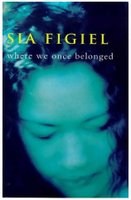 In Samoa I am not guided so much as welcomed ashore and offered the freedom to roam - in and out of peoples homes, hearts and minds. I am not told a story so much as handed a pack of postcards - snapshots to take and treasure.
In Samoa I am not guided so much as welcomed ashore and offered the freedom to roam - in and out of peoples homes, hearts and minds. I am not told a story so much as handed a pack of postcards - snapshots to take and treasure.
For the 236 pages of Where We Once Belonged I become part of the ‘we’ that is Samoa and I learn, through experience, how individuality steps back just as communal identity steps forward.
 Sia Figiel uses a language like my own, but twists it wholly to her purpose, spinning familiar words together on exotic and unruly strings to give unforgettable descriptions of people (‘Sale wore a sharkface’.) and places (‘waves cry diesel tears’).
Sia Figiel uses a language like my own, but twists it wholly to her purpose, spinning familiar words together on exotic and unruly strings to give unforgettable descriptions of people (‘Sale wore a sharkface’.) and places (‘waves cry diesel tears’).
With stunning illogical logic she shows how youth is the same but also different for girls the world over.

‘If you can answer riddles and rhyme land animals with sea animals, then you have passed the test and it is clear that you don’t like boys’.
I see children learning about themselves and approaching adulthood. Interacting with significant adults such as the teacher who ‘drank children-tears, ate boy-humiliation and devoured a girls pain’. I join them in embracing their culture and community and the ways beyond these islands. I share the excitement of the first television to enter a home - and also the disappointment once they discover its limitations. No aerial equals no picture.
 Once again I catch a brief glimpse of my own culture through distant eyes as the school children are made to recite Wordsworth without a clue to the true nature of a daffodil, prompting one child to suggest - ‘A daffodil is a dancer that lives in the sky’. Proving that imagination and ignorance are always more poetic than truth.
Once again I catch a brief glimpse of my own culture through distant eyes as the school children are made to recite Wordsworth without a clue to the true nature of a daffodil, prompting one child to suggest - ‘A daffodil is a dancer that lives in the sky’. Proving that imagination and ignorance are always more poetic than truth.
the circumnavigator
 In
In  Sia Figiel uses a language like my own, but twists it wholly to her purpose, spinning familiar words together on exotic and unruly strings to give unforgettable descriptions of people (‘Sale wore a sharkface’.) and places (‘waves cry diesel tears’).
Sia Figiel uses a language like my own, but twists it wholly to her purpose, spinning familiar words together on exotic and unruly strings to give unforgettable descriptions of people (‘Sale wore a sharkface’.) and places (‘waves cry diesel tears’).
 Once again I catch a brief glimpse of my own culture through distant eyes as the school children are made to recite Wordsworth without a clue to the true nature of a daffodil, prompting one child to suggest - ‘A daffodil is a dancer that lives in the sky’. Proving that imagination and ignorance are always more poetic than truth.
Once again I catch a brief glimpse of my own culture through distant eyes as the school children are made to recite Wordsworth without a clue to the true nature of a daffodil, prompting one child to suggest - ‘A daffodil is a dancer that lives in the sky’. Proving that imagination and ignorance are always more poetic than truth.